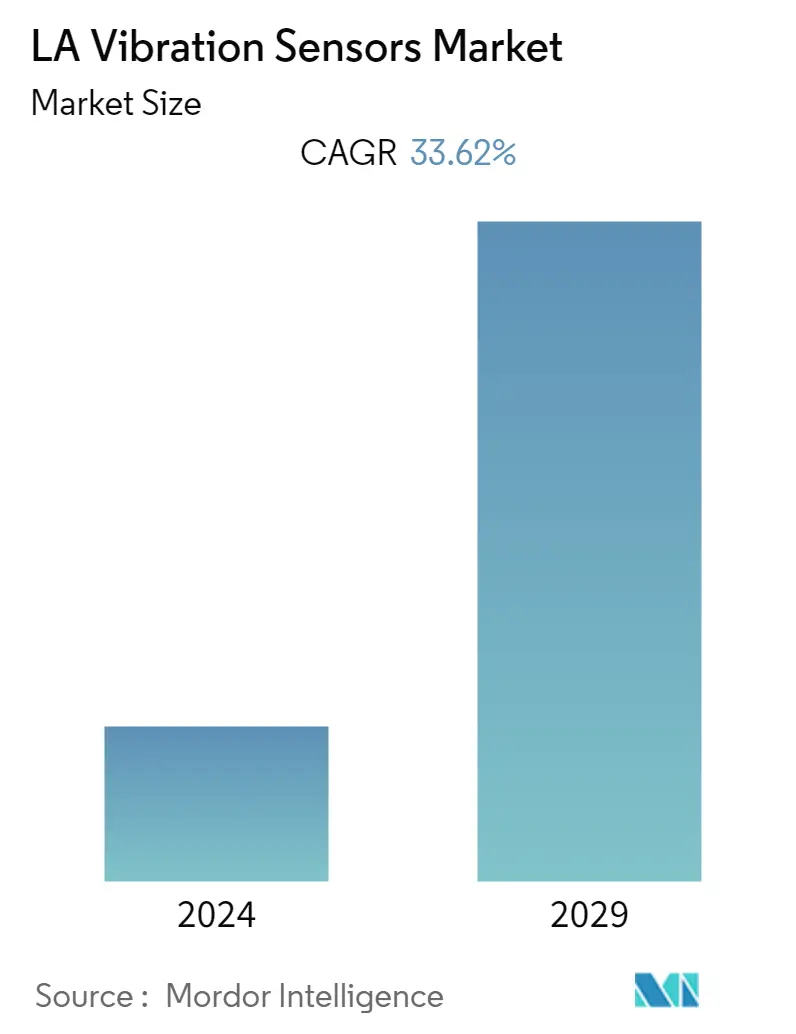Market Size of LA Vibration Sensors Industry

| Study Period | 2019 - 2029 |
| Base Year For Estimation | 2023 |
| Forecast Data Period | 2024 - 2029 |
| Historical Data Period | 2019 - 2022 |
| CAGR | 33.62 % |
| Market Concentration | Low |
Major Players.webp)
*Disclaimer: Major Players sorted in no particular order |
Need a report that reflects how COVID-19 has impacted this market and its growth?
LA Vibration Sensors Market Analysis
The Latin America Vibration Sensors market is expected to register a CAGR of33.62 % during the forecast period (2021-2026). Vibration analysis and engine trim balance instruments and accessories for commercial and military aviation. As there is a rapid improvement in sensors as the airline industry usage is high where turbulence can be reduced.
- Latin America's growth is mainly attributed to the developing economies in the region, such as Brazil and Argentina. Brazil is involved in adopting and promoting smart technology in various industries, such as consumer electronics, oil and gas, wind power, aerospace, and automotive, among others.
- The consumer electronics industry, especially smartphones, in countries like Brazil is exhibiting a moderate outlook. For instance, in 2019, the smartphone market in Brazil witnessed a boost in revenue, despite a 6% decline in the number of units sold.
- Their application in the oil and gas industry to handle the speed rotation of gears and turbines in high frequency ranges from 10 Hz to 10 kHz augments the demand further. BP PLC, an oil and gas company based out of London, United Kingdom, estimates that Brazil could attract about USD 22 billion worth of investment in the oil sector in each of the next five years. Owing to this, production is expected to increase to around 3.7 million BPD by 2025. This provides the scope for expansion, possibly in new projects. Such statistics highlight the rising demand for vibration sensors in the sector.
- Besides, owing to the ability of the sensor to be used in the wind power industry for slow rotation of turbines (1 Hz or less frequency), the scope of deployment is high in the country. The wind power sector is the largest initiative in the country and is the second-largest source in the energy matrix. According to ABEEólica (the Brazilian Wind Energy Association), the installed capacity of wind power in the country reached 16 GW, with about 637 wind farms and 7,738 wind turbines, by the first half of 2020.
- In August 2020, Dario Martinez, new energy secretary, announced the plan to promote oil and natural gas production in the country with a view to increasing exports. Such initiatives drive the demand for vibration sensors in the dominant sector. However, the COVID-19 pandemic has threatened the fracking project in the country and left the government of Argentina in a dilemma whether or not to continue support for the vast Vaca Muerta oil and gas fields in Patagonia.
